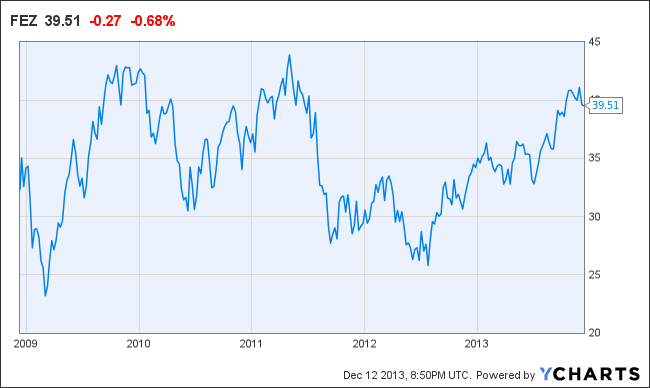The U.S. stock market has enjoyed a monster rally in 2013 with the S&P 500 Index (SPX) delivering returns of roughly 27% as of Dec. 11.
In 2014, though, the real action may be in Europe if investors start to rotate away from the U.S. and into European stocks as the debt crisis recedes and to position for a rebound in emerging markets.
SPDR EURO STOXX 50 ETF (FEZ)
Goldman Sachs is very upbeat about European equities (Japanese stocks, too) next year, according to the investment bank’s latest asset allocation report. Goldman’s European equity team has set a 2014 target of 360 for the Stoxx Europe 600 index (SXXP). If realized, that would add up to a 13% return from current levels. (The SXXP is up 12% on the year through Dec. 11.)
The bullish case for the region rests on the assumption that corporate margins to pick up from cyclically low levels, according to Peter Oppenheimer, European equities strategist at Goldman Sachs.
While Eurozone economies such as Spain, Italy, Portugal and Greece face challenges, the region has pulled out of its recession and European Central Bank stimulus and monetary easing have steadied the financial markets and banking systems. Says Oppenheimer:”There are still latent risks in Europe due to the large outstanding debt stocks, but the near-term risks from this have been declining and we do expect European growth to pick up.”
Pascal Blanque, global chief investment officer at Amundi Asset Management, describes Europe as a “sleeping beauty waiting to be awakened.” There could be a rotation of money out of the U.S., where political gridlock is rampant, and into European markets. “We will see diversification outside the U.S. next year due to maturing valuations,” he told CNBC.
Over at Kiplinger’s, Anjelica Tan points out in a recent post that by some measures European stocks are already outperforming U.S. markets and are still a bargain:
The MSCI Europe index, a broad benchmark of large stocks, topped the 12.1% gain of Standard & Poor’s 500-stock index by 1.1 percentage points over the past six months (ended Dec. 5). Yet European stocks, valued at 13 times estimated 2014 earnings, are relatively cheap compared with the forward price-earnings ratio of 15 for U.S. stocks. Global money managers are now overweight in European stocks, according to a recent survey by Bank of America Merrill Lynch. About 60% of European fund managers expect the region’s companies to increase earnings over the next year.
Valuation for the U.S. stock market rose 19% this year, accounting for most of the market’s gain, while in Europe, equity valuation rose only 8%, notes Josh Brown at The Reformed Broker blog.
Another Europe bull is Charles Sizemore, founder and chief investment officer of Sizemore Capital and manager of the Covestor Global Macro Portfolio. (Ten of the portfolio’s 22 current holdings are domiciled in Europe.) His case for European stocks is outlined here.
Aside from attractive valuations, Sizemore notes that regional credit markets have stabilized and European companies have better indirect exposure to emerging markets than their American counterparts. That was a negative when investors dumped developing market stocks, but could be a big plus if emerging markets, especially China, rebound.
Or course, the Eurozone debt crisis flaring up again is an ongoing risk of investing in the region. Also, geopolitical tensions have emerged in Ukraine.
Still, Societe Generale is predicting that some $100 billion in portfolio money could soon flow back into European stock markets via mutual and ETFs. Add it all up, and the bullish case for Europe isn’t a bad one.
Photo Credit: Skley
Disclaimer: All investments involve risk and various investment strategies will not always be profitable. International investing involves special risks, such as political instability and currency fluctuations. Past performance does not guarantee future results.






